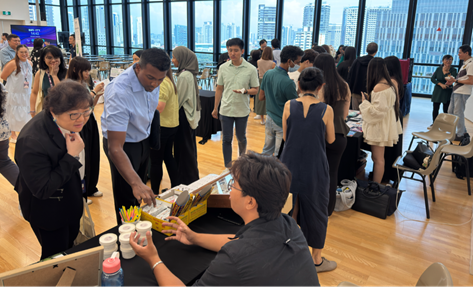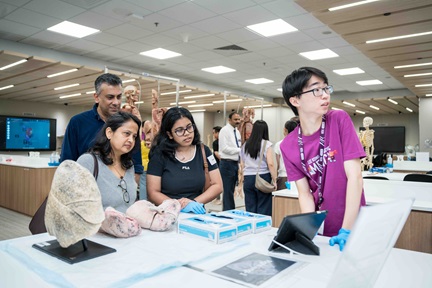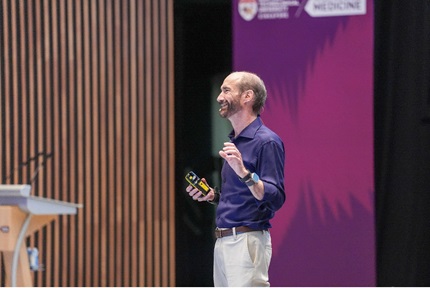New Research Unravels Mystery of Limb Development

New research by scientists from Nanyang Technological University, Singapore (NTU Singapore), the University of Colorado (CU) School of Medicine and the Agency for Science, Technology and Research (A*STAR) have unravelled the mystery of how our limbs evolved from our fishy ancestors.
The evolution of our different body parts — particularly how our paired limbs evolved from the fins of ancient fish — has been a major field of study since the publication of Charles Darwin’s On the Origin of Species. One of the two main theories for how our arms and legs form from ancient fish, suggest that the paired limbs evolved from a hypothesised pair of fin folds present on the sides of the fish which in turn was developed from an ancient single unpaired fin. As this transition occurred, it was theorised that the fins likely changed their properties that were originally from the ancient fins to those of our limbs.
Despite years of studies and discussion, the lack of solid evidence for the intermediate structures predicted by this theory has left the long-standing and contentious debate unresolved up to now.
This missing piece about the origin of paired appendages has been uncovered through new research published in Nature in May 2023 by an international team led by Lee Kong Chian School of Medicine (LKCMedicine) at NTU Singapore and CU School of Medicine, Anschutz Medical Campus.
Assistant Professor Tom Carney from LKCMedicine and Associate Professor Christian Mosimann from CU School of Medicine are co-investigators of this research.
Together, the researchers identified a single unpaired fin in zebrafish larvae that unexpectedly shares its developmental origin with the paired fins, rather than other unpaired fins. This identifies it as a likely intermediate structure in the transition from the unpaired fins to limbs.
The researchers showed that this fin was a very ancient invention and is populated by cells that also contribute to the cardiovascular system. Simple tuning of cell signals can convert this intermediate structure into paired fins, an essential step in the evolution of paired limbs. This work provides missing pieces of evidence to the very old debate about how limbs evolved and how this occurred in relation to other structures in the embryo.

This breakthrough was made possible by Asst Prof Carney’s and Assoc Prof Mosimann’s exchange of research information and the collaboration between their labs based in Singapore and Colorado, respectively.
Asst Prof Carney shared, “Christian was visiting Singapore for a conference in Singapore a few years ago and showed me some of his unpublished data, including the missing cells we had been looking for. Surprisingly, we saw that they came from the same source as our limbs, an embryonic cell layer called the lateral plate mesoderm. We immediately knew the significance. This fin looked like an intermediate evolutionary step between fins and our limbs.”
Assoc Prof Mosimann added, “We always knew these cells were odd. There were these fibroblast-looking cells that went into the so-called ventral fin, the fin at the belly of the developing zebrafish. Similar fibroblast cells didn’t crawl into any other fin except the pectoral fins, which are the equivalent of our arms. So, we kept noticing these peculiar fibroblasts, and we could never make sense of what these were for many years.”
With these new clues on what this might be, the teams collaborated to unravel the mystery.
The Singapore team led by Asst Prof Carney included scientists from LKCMedicine and A*STAR.
“Our lab showed that we could adapt simple cell labelling techniques from zebrafish to other species, allowing us and our collaborators around the world to demonstrate that this intermediate step in evolution is present in many other species of fish and in frogs, showing that was an ancient invention, occurring at a time consistent with the expected evolutionary timeline.”
He elaborated, “We could also show with simple tuning of cell signals, that this fin can also be readily duplicated into the hypothesised paired fin folds. Indeed, we found that in some popular goldfish strains, such as the Ranchu, these duplicated side fins can occur naturally and look like the missing intermediate structures of the old fin fold hypothesis. Thus, our work adds extremely important support for this long-standing argument for how our paired arms and legs evolved from unpaired fins.”
Meanwhile, the Mosimann lab, has also developed several techniques to track cell fates during development in pursuit of their main topic, which is an improved understanding of how the lateral plate mesoderm contributes to diverse organs. The lateral plate mesoderm is the developmental origin of the heart, blood vessels, kidneys, connective tissue, as well as major parts of limbs.
“This was such a fantastic collaboration between my lab in Singapore and Christian’s lab in Colorado. Aside from importance to the debate on the origin of our limbs, it shows how limbs and fins grow and are shaped,” said Asst Prof Carney.
Through this breakthrough, scientists now understand the different potentials of cells during development and the signals that direct them to different organs, providing insights on manipulating cells for regenerative outcomes such as regrowing organs.







